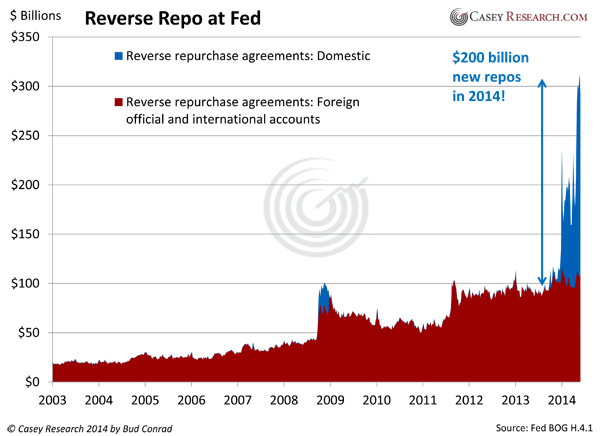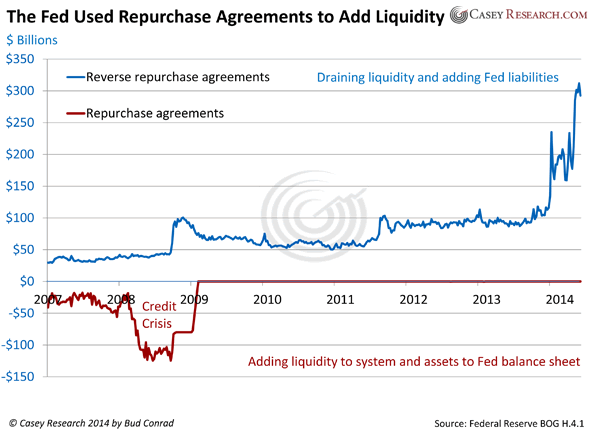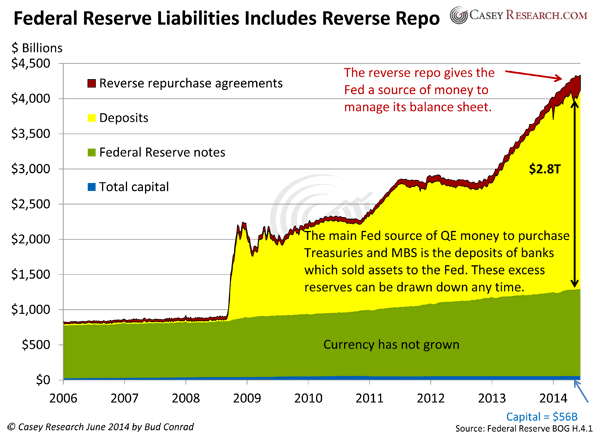The Fed’s Stealth Tightening
Interest-Rates / US Interest Rates Jun 23, 2014 - 04:26 PM GMTBy: Casey_Research
 By Bud Conrad, Chief Economist
By Bud Conrad, Chief Economist
As expected, the Fed tapered its purchases of mortgage-backed securities on Wednesday to $15 billion per month and its purchases of longer-term Treasury securities to $20 billion per month.
That means total monthly purchases, which were $85 billion last year, are now down to $35 billion. That’s a significant cut.
The Fed also cut the range of its full-year 2014 real GDP growth forecast, from 2.8% – 3.0% down to 2.1% – 2.3%. That was no surprise, considering that GDP in Q1 was negative 1%, and it may have been a bit of a warning.
Those who are familiar with my work know my no-confidence stance on Fed prognostication. But just to make my opinion clear: I think the Fed is in the business of obscuring the truth. Official inflation numbers vastly understate actual price rises:
- Housing in California is back to its pre-crisis peak;
- Stocks are at record levels;
- Food prices jumped 0.7% in May alone; and
- Anyone who drives knows that a tank of gas is far more expensive than it was a year ago.
The Fed’s claim that inflation is contained and that there is no need to raise interest rates is just a show put on for people who believe the government. If we applied a more accurate inflation rate to GDP calculations, real GDP would not be growing at all.
My point is that the Fed and the media tell us things are better than they actually are. Meanwhile, the Fed is taking secret actions that reveal where Yellen and friends really think the economy might be headed.
The Fed’s New Tool: Reverse Repo
Traders have used Repurchase Agreements ("repos") for decades. A repo is essentially a collateralized loan. A borrower sells government securities to a lender and buys them back later at an agreed-upon date and slightly higher price. The lender takes on very little risk to earn a small amount of compensation while it holds the government securities as collateral.
Repos can last for any amount of time, but they are often ultra-short-term. Overnight repos are the most common.
The Fed has announced that it’s using “reverse repos” as a new tool to manage monetary policy. Don’t let “reverse” confuse you: Reverse repos are just a way the Fed soaks up cash from financial institutions. The Fed is the “borrower,” swapping its Treasuries for banks’ cash. You might call it the opposite of quantitative easing: reverse repos drain money from the financial system.

The Fed can also use repos to add money to the system, as it did in the early stages of the 2008 Credit Crisis:

By netting repos with reverse repos, we can see their combined effect on monetary policy over time:

As you can see, the Fed is quietly using reverse repos to drain the money supply. Remember, this is on top of the taper. Net, the Fed is being less accommodative than most are aware of.
How Repos Fit into the Fed’s Balance Sheet
The following chart illustrates how the Fed’s liabilities (sources of funding) changed dramatically during the financial crisis.
The Fed funded and continues to fund its quantitative easing programs with bank deposits. Here’s the rundown on how that works:
- The Fed creates cash from thin air.
- The Fed buys Treasuries and mortgage-backed securities (MBS) from banks with that freshly minted cash.
The Fed pays banks 0.25% interest as an incentive to keep the new cash on deposit at the Fed.

That huge $2.8 trillion in deposits is a risk source, because the financial institutions could withdraw those funds at any time, if they think they can generate better returns than the 0.25% interest that the Fed pays.
Reverse repos are also a source of funding for the Fed: they provide cash for the Fed to continue purchasing Treasuries and mortgage-backed securities.
Though reverse repos are only a small portion of the Fed’s balance sheet, they are important. As the growth of the yellow “deposits” has trailed off, reverse repos have picked up much of the slack.
In effect, the Fed has sopped up $200 billion in the last nine months in “stealth tightening.” I use the word "stealth," because most investors, and even most Fed watchers, aren’t aware of the effects of reverse repos.
You’re probably wondering, "What’s the Fed’s ultimate plan here?"
I think that the Fed is using reverse repos to build up a hidden source of funding so that it can unwind its tightening quietly, if need be. The Fed now has $200 billion in “ammunition” that it can deploy without much (or any) fanfare, because nobody is following this closely. “Reverse Repos” isn’t the headline grabber that “Quantitative Easing” is.
As a side note, notice that the Fed’s capital is so small that you can barely see it. If the Fed were a bank subject to market forces, the slightest negative surprise would render it insolvent. But of course, it has a monopoly over the printing press, so it needn’t worry about such things.
One last reason the Fed might be secretly building a rainy-day fund: As my analysis in the newest issue of The Casey Report demonstrates, foreigners have recently stopped lending money to the US. That’s a huge problem for a country that had a $111.2 billion trade deficit in the first quarter alone, and will spend half a trillion more dollars than it takes in during 2014.
As I said earlier, the Fed has been very quiet about this repo program, so we can only surmise what its true motivations are. But as the US government’s lender of last resort, the Fed may be raising this source of cash so it can lend more money to the US government as foreign lending continues to dry up.
In conclusion, the credit crisis of 2008 changed our financial system in many ways. Whether this latest repo experiment is just another Band-Aid on the money balloon or something more, it’s well worth keeping an eye on.
You can find my data-driven analysis in every single edition of The Casey Report. Start your 90-day risk-free trial now to read the current issue plus two more, access all of the current stock picks, and peruse the archives before deciding if The Casey Report is for you. If it’s not, no problem—just call or email for a full and prompt refund. Click here to start your no-risk trial subscription to The Casey Report straightaway.]
Disclaimer: The above is a matter of opinion provided for general information purposes only and is not intended as investment advice. Information and analysis above are derived from sources and utilising methods believed to be reliable, but we cannot accept responsibility for any losses you may incur as a result of this analysis. Individuals should consult with their personal financial advisors.
Casey Research Archive |
© 2005-2022 http://www.MarketOracle.co.uk - The Market Oracle is a FREE Daily Financial Markets Analysis & Forecasting online publication.



